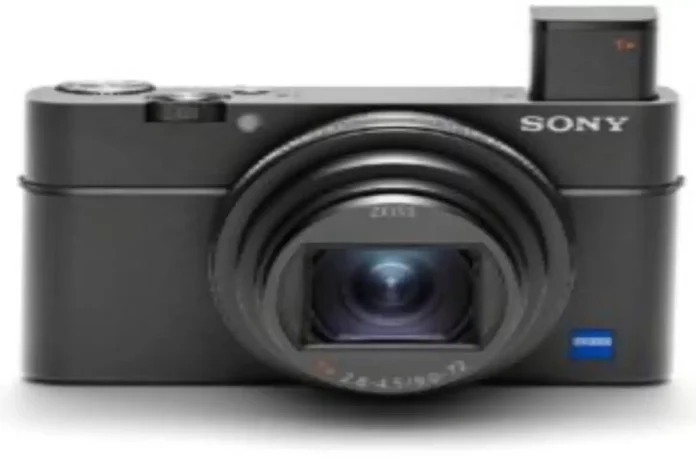Sony RX100 VII
From the absence of expected features to its lofty price tag, there’s plenty to irk those drawn to the likes of the Sony RX100 VII.
And yet, with its strong image quality, detailed 4K videos and a class-leading AF performance.
Table of Contents
Sony RX100 VII – Design and features
- As for the design – there’s not a whole lot to say here. Sony has kept the same form factor for the RX100 VII as its predecessor, the RX100 VI.
- That’s not a big surprise since the upgrades for this model come under the hood.
- So, essentially what that means is that you get something very pocketable.
- Which houses a 20.1MP one-inch CMOS sensor (which is new) and couples it with a very flexible 24-200mm (8.3x) optical zoom (which isn’t).
- A couple of generations ago, Sony decided that users would rather have a longer zoom than a shorter one with a wider aperture, so the maximum you can go here is f/2.8.
- Which is still bright enough for most situations. Also returning is the tilting screen and nifty hidden away pop-up viewfinder for composing.
- Additionally, there are now 357 phase-detection autofocus points which cover 68% of the frame.
- With yet another “world’s fastest autofocus” of 0.02 seconds also promised. We’ve also got the addition of Animal Eye AF to build on the success of the already installed Eye AF.
Screen and Viewfinder
- Sony first introduced a pop-up viewfinder for its RX100 series a few generations ago.
- It allows you to frame your shots in a more traditional way than using the screen.
- As well as coming in particularly handy when shooting in bright light.
- Happily, the viewfinder pops up and automatically extends out to be ready to use from the get-go, which compares well with the Canon G5X.
- Mark II requires a two-step pop up and pull out kind of motion that can occasionally lead to missed shots.
- Although not huge, the RX100 VII’s viewfinder is bright and clear, and I found myself using it on several occasions.
- It can be hiding away when not in use helps keep the lines of the camera nice and sleek while also getting it out of the way of the tilt-up screen.
Sony RX100 VII – Performance
- Sony has already proved, time and time again, just how remarkable its technology is.
- Especially for such a pocket-friendly camera – in previous generations of the RX100 series.
- Herewith the RX100 VII builds on that success, bringing features such as 90fps shooting.
- Generally speaking, you’re probably going to want to leave it on 20fps so you can enjoy full-time AF and blackout-free shooting.
- Overall, engaging continuous AF and selecting the fast frame rate means that the RX100 VII keeps up well with reasonably predictably moving subjects.
- It is probably not a camera wholly intended for sports photography, but with the long lens and fast shooting.
- You can get some decent spectator shots at football games and so on, while it’s also useful for subjects such as pets and children.
- In other situations, the RX100 VII locks on to most subjects very quickly, very rarely producing a false confirmation of focus.
- In shallow light conditions, you might notice it takes a little bit longer, but it’s still pretty impressive even when there’s very little available light to work with.
Sony RX100 VII – Image Quality and Video
- It is another area where Sony has consistently proved that it can deliver.
- Images directly from the camera show a satisfying amount of punch, with vibrant yet realistic colours.
- There’s also an excellent overall impression of detail throughout the native sensitivity range when viewing images at everyday printing or web sites.
- Despite not having the f/1.8 maximum aperture, we saw on early generations of the RX100 series.
- You can still produce excellent shallow depth of field images in the right conditions.
- The flexibility of the longer lens being worth the broad aperture sacrifice on the whole.
- In low light, not having that wide aperture also means that you’ll probably have to shoot at reasonably high ISO settings.
- Images were taken at ISO 6400 display well at small sizes, but you can see some loss of detail if examining photos at 100%.
- But noise is kept to a minimum. Shooting in the raw format gives you the scope to bring back some missing detail if you feel the noise-reduction has gone overboard.
- Video quality remains as good as the RX100 VI with finely detailed footage.
- Image stabilisation kicks in to help keep things as smooth as possible – and while I wouldn’t rely on it for super dangerous conditions (such as mountain biking).
- For the average walkaround vlog it does an excellent job of keeping things smooth.
Also Read: Low Maintenance Haircuts – 4 Best Low Maintenance Haircuts
Also Read: Best Jade Roller – 4 Best Jade Rollers, and More


Review Sony RX100 VII – Design, Features, Screen, Performance, and More.